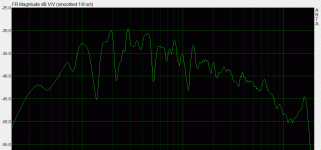It's not that I'm on to something, it's something that I have not voiced. This is one reason why having the listening position facing a corner rather than facing a wall has often benefits playback quality. I've done that over 20 years ago.
If one really has to listen in a double blind test with each test track longer than a minute to decide what is desireable, then the difference has no significance to an average user. Rather, it is more beneficial to find the type of music that will help make the difference more noticeable within the first minute of listening.
I have spent lots of time learning how to listen, and detect where more improvement can possibly be applied, room, speaker, or electronics. I think anyone with a passion for better sound reproduction would benefit from this kind of self training. But the desire for better reproduction must be stronger than trying to compare who or which is better for one to hold a steady course on improvements.
If one really has to listen in a double blind test with each test track longer than a minute to decide what is desireable, then the difference has no significance to an average user. Rather, it is more beneficial to find the type of music that will help make the difference more noticeable within the first minute of listening.
I have spent lots of time learning how to listen, and detect where more improvement can possibly be applied, room, speaker, or electronics. I think anyone with a passion for better sound reproduction would benefit from this kind of self training. But the desire for better reproduction must be stronger than trying to compare who or which is better for one to hold a steady course on improvements.
...a slightly falling direct response with a parallel falling power response. This is the way of nature and it only seems logical that it is what we perceive as natural.
After voicing by ear, I took this from my listening position. Despite the looks, it doesn't sound bad.
Not sure if I should equalise. I dislike sibilance.
Attachments
Last edited:
After voicing by ear, I took this from my listening position. Despite the looks, it doesn't sound bad.
Not sure if I should equalise. I dislike sibilance.
That is "slightly" falling?
Sheldon
The better link would have been the whole story,
3D3A Lab at Princeton University
But I guess thats typical.
This is an old model Nathan.
3D3A Lab at Princeton University
But I guess thats typical.
This is an old model Nathan.
And we are among pals....
Your kidding of course - well yes thats what the smily face means.
That is "slightly" falling?
Sheldon
Um, I need to take that plot back and apologise. The kids were playing with the EQ before I started. Some exposure to solder fumes and a passworded screen saver later, and all's well.
Um, I need to take that plot back and apologise. The kids were playing with the EQ before I started. Some exposure to solder fumes and a passworded screen saver later, and all's well.
For an "in-room" curve I found the "slope" completely reasonable. In any room, the HF response of the steady state will fall for several reasons. The power response almost invariably fall (my speakers being on the exceptional high-end of this), and the absorption always goes up at HFs. This yields an expected fall of at least 3 dB per octave for the steady state sound levels. However, my steady state measurements -spatially averaged, as they have to be - tend to be quite a bit smoother than whay you showed.
Zilch posted:
You should be feeling pretty good about how these independent third-party measurements substantiate what you have previously posted here, Earl, and I am pleased to finally see the verticals.
Isn't that like kissing your sister?...for one of you, anyway...
NotedFor an "in-room" curve I found the "slope" completely reasonable.
Ya HAD to've been there, Ed....Isn't that like kissing your sister?...for one of you, anyway...
For an "in-room" curve I found the "slope" completely reasonable.
The slope shape looked fine to me. I was questioning the amplitude.
Sheldon
The slope shape looked fine to me. I was questioning the amplitude.
Sheldon
yeah, looks like 15dB rolloff above 1k (to 10k, we'll ignore 10-20k). Completely overdamped top end imo.
How can this be though if the Abbeys and Summas are incredible speakers??
Simple - it's incorrect.
Im confused again about CTC issues. There is a discussion on another forum that round OS Waveguides do not have close enough CTC with the woofers so they will have issues.
How can this be though if the Abbeys and Summas are incredible speakers??
Just like anything else, it's a balancing act. They feel the vertical lobing is a greater issue than the good Dr. does. To get the lobing minimized, they have elliptical/rectangular waveguides, which invariably fail to load as low as an axisymmetric of similar width, in the vertical plane. The bottom end cutoff is a rough region in these types of horns, so that has its own problems.
Further, the best power response/axial response matching can only be achieved when matching the conical behavior of a cone to a round waveguide. It all boils down to how much of one thing you're willing to accept to get another. Both are valid approaches and can sound excellent.
- Home
- Loudspeakers
- Multi-Way
- Geddes on Waveguides

 ]
]